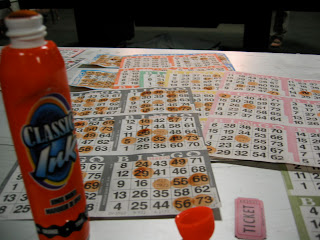
Once a month, the Marines host a tour of the Northeast Gate which is the only legal crossing point between GTMO and Cuba.** We decided to take advantage of this tour along with about 50 other folks, filling two buses. Prior to the tour getting underway, we watched the morning "Call to Colors" in which the American flag is raised while the national anthem is played over loudspeakers.
The 15 minute drive to the Northeast Gate crosses salt flats once filled with over 50,000 land mines which have mostly been removed.
 During the early 1950’s over 4,000 Cubans came through the gate to work on the base. However, with the Cuban revolution in 1959, things changed -- the U.S. banned entrance into Cuba and Castro cut off the labor supply of Cubans to the base.
During the early 1950’s over 4,000 Cubans came through the gate to work on the base. However, with the Cuban revolution in 1959, things changed -- the U.S. banned entrance into Cuba and Castro cut off the labor supply of Cubans to the base.Presently, just three Cuban men, all in their 80’s, arrive on the Cuban side at 6:00 a.m. daily, walk across, and work on the base. “Work” is loosely defined -- their main task is carrying retirement checks back across the border to those Cubans no longer working on the base.

This sign on the Cuban side of the gate may be translated two different ways:
"The Republic of Cuba - Free Country of America" or "The Republic of Cuba - Country Free of America."

In 1964, the Cuban government ordered the water supply to the base be cut off. This was in retaliation to the arrest of 36 Cubans who were found fishing illegally in Florida waters. When the water cut-off occurred, there were about 14 millions gallons of water in storage on the base. Strict rationing was initiated.
When accusations were made by the Cuban government that the base was stealing water from Cuba, the admiral at that time ordered that sections of water pipe be cut and permanently removed to disprove the allegation. (This is a photo of where the section of pipe was cut and removed.) To help the base become as self-sufficient as possible, a huge desalinization plant was dismantled in California and transported to GTMO. In six short months, the plant was de-constructed, transported, re-constructed, and operational on the base.

Our understanding is that a respectful relationship is currently in place between the Marine sentries and the Cuban guards throughout the 17 miles of existing fence line.
Opposite is a photo of a Cuban sentry outpost. You can see two guards, one who is looking at us through binoculars.
We have been informed that preparations are being made for the day that normalized relations resume between the U.S. and Cuba. It is expected at that time over 50,000 Cubans will cross the gate into the base.
**Approximately six to ten Cubans attempt a water crossing from Cuba to Florida every month. And about four to six Cubans try either by land or by water to get into the base.















